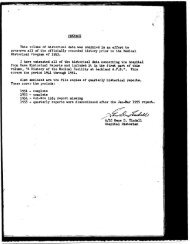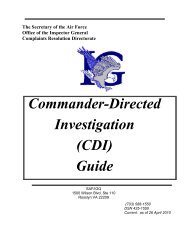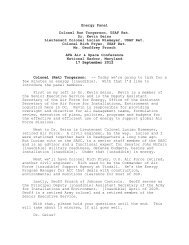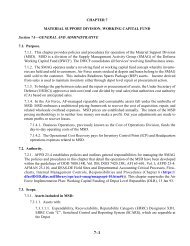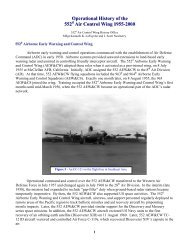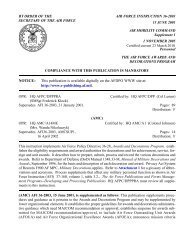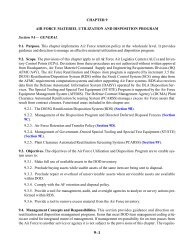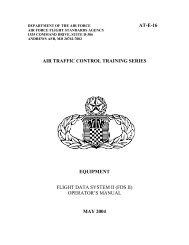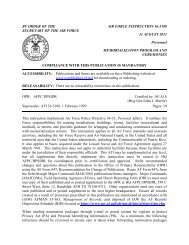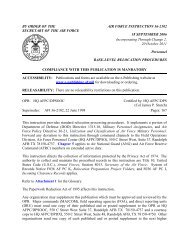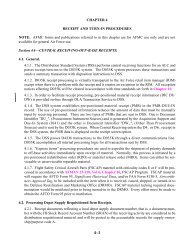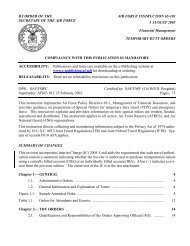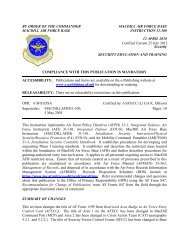CONTRAILS FACTS - Air Force Link
CONTRAILS FACTS - Air Force Link
CONTRAILS FACTS - Air Force Link
- TAGS
- contrails
- link
- www.af.mil
You also want an ePaper? Increase the reach of your titles
YUMPU automatically turns print PDFs into web optimized ePapers that Google loves.
Photographs which show military aircraft with sprays coming from unusual locations on the<br />
aircraft are usually re-touched photos (a process that is easy to create using common computer<br />
programs).<br />
Cloud Seeding and Fire Suppression<br />
For a number of years commercial companies<br />
have been involved in cloud seeding and fire<br />
suppression measures. Cloud seeding<br />
requires the release of chemicals in the<br />
atmosphere in an effort to have water crystals<br />
attach themselves and become heavy enough to produce rain. The <strong>Air</strong> <strong>Force</strong> does not have a<br />
cloud seeding capability.<br />
Fire suppression involves dumping chemicals onto a<br />
fire using cargo-type aircraft or helicopters. The 731st<br />
<strong>Air</strong>lift Squadron assigned to the 302nd <strong>Air</strong>lift Wing,<br />
Peterson <strong>Air</strong> <strong>Force</strong> Base, CO., is trained in the use of<br />
modular airborne fire fighting systems that help<br />
firefighting efforts of the U.S. Forest Service by<br />
dropping retardant chemicals directly onto fires. The<br />
unit’s C-130s are loaded with a system designed to<br />
airdrop fire-retardant chemicals used in fighting forest<br />
fires and fertilizing the forest to generate quick<br />
regrowth. The 302nd AW has conducted firefighting response in Colorado, California, Oregon<br />
and Idaho.<br />
U.S. forest fires generally occur in desolate, almost<br />
inaccessible geographical areas. The U.S. Forest<br />
Service turned to air power to help its ground fire<br />
fighting units quickly contain and suppress these fires.<br />
Over the years, the forest service has developed a<br />
highly effective air-attack organization and air tanker<br />
fleet to deal with the forest fire emergency.<br />
In 1970, however, numerous catastrophic forest fires<br />
erupted in southern California, severely overloading the<br />
air tanker fleet's ability to cope with them all. This led to several U.S. Congressmen requesting<br />
the U.S. <strong>Air</strong> <strong>Force</strong> help the forest service by making military aircraft available as a back-up<br />
measure. This in turn led to the development of the Modular <strong>Air</strong>borne Fire Fighting System<br />
(MAFFS). The system is designed to quickly adapt military C-130 aircraft from a military role to<br />
a fire-suppression role.<br />
Since 1974, the U.S. <strong>Air</strong> <strong>Force</strong> Reserve and <strong>Air</strong> National Guard units<br />
strategically located near high-incident forest fire areas have been<br />
equipped with these MAFFS units, and have sent selected aircrews to<br />
the aircrew training school for instruction in forest service air operations<br />
and procedures.<br />
The MAFFS System is a modular, reusable airborne system for<br />
deploying water and fire retardant chemicals from aircraft in flight. It




